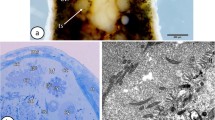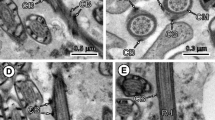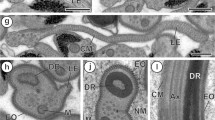Abstract
Two questions are of interest concerning the male reproductive system in Gordiida: (1) is the epithelium surrounding the testis continuous or discontinuous and (2) is the type of spermatozoon as described at the transmission electron-microscopical level for the two species of Gordius typical for all Gordiida? An examination of the South American species Pseudochordodes bedriagae has allowed us to add new information to this poorly studied phylum. Testicular tubes are large, filled with spermatozoa, and surrounded by a continuous epithelium. The epithelial cells that line the posterior testes occasionally overlap, and their cytoplasm is narrow and contains dense granules, abundant endoplasmic reticulum, and vesicles. The plasma membrane possesses microvilli with many filaments. This epithelium rests on a basement membrane. The spermatozoa in P. bedriagae resemble the known spermatozoa of two Gordius species but differ in presenting a uniform halo layer of less dense chromatin that surrounds the dense chromatin in the nucleus. The finding that a similar type of spermatozoa occurs in both genera (Pseudochordodes and Gordius) makes it likely that it is present in all other Gordiida and is therefore an autapomorphy of the Gordiida.









Similar content being viewed by others
References
Baccetti B, Dallai R, Grimaldi de Zio S, Mariari A (1983) The evolution of the Nematode spermatozoon. Gamete Res 8:309–323
Bleidorn C, Schmidt-Rhaesa A, Garey J (2002) Systematic relationships of Nematomorpha based on molecular and morphological data. Invertebr Biol 121:357–364
Bolek MG, Coggins JR (2002) Seasonal occurrence, morphology, and observations on the life history of Gordius difficilis (Nematomorpha: Gordioidea) from southeastern Wisconsin, United States. J Parasitol 88:287–295
Bresciani J (1991) Nematomorpha. In: Harrison FW, Ruppert EE (eds) Aschelminthes. Microscopic anatomy of invertebrates, vol 4. Wiley-Liss, New York, pp 197–218
Justine JL, Jamieson BGM (1999) Nematoda. In: Jamieson BGM (ed) Progress in male gamete ultrastructure and phylogeny, reproductive biology of invertebrates, vol 9. Oxford University Press, Oxford, pp 183–266
Lanzavecchia G, de Eguileor M, Valvassori R, Scari G (1995) Body cavities: of Nematomorpha. In: Lanzavecchia G, Valvassori R, Candia Carnevali M (eds) Body cavities: function and phylogeny. Mucchi, Modena, pp 45–60
Lee DL (1971) The structure and development of the spermatozoon of Heterakis gallinarum (Nematoda). J Zool Lond 164:181–187
Lora Lamia Donin C, Cotelli F (1977) The rod-shaped sperm of Gordioidea (Aschelminthes, Nematomorpha). J Ultrastruct Res 61:193–200
May HG (1919) Contributions to the life histories of Gordius robustus (Leidy) and Paragordius varius (Leidy). Ill Biol Monogr 5:1–119
Meissner G (1856) Beiträge zur Anatomie und Physiologie der Gordiaceen. Z Wiss Zool 7:1–144
Montgomery TH (1903) The adult organisation of Paragordius varius (Leidy). Zool Jahrb Anat Ontog 18:387–474
Poinar GO (2001) Nematoda and Nematomorpha. In: Thorp JH, Covich AP (eds) Ecology and classification of North American freshwater invertebrates, 2nd edn. Academic Press, San Diego, pp 255–295
Poinar GOJ, Hess-Poinar RT (1993) The fine structure of Gastromermis sp. (Nematoda: Mermithidae) sperm. J Submicrosc Cytol Path 25:417–431
Rauther M (1905) Beiträge zur Kenntnis der Morphologie und der phylogenetischen Beziehungen der Gordiiden. Z Naturwiss 40:1–94
Schmidt-Rhaesa A (1997) Ultrastructural observations of the male reproductive system and spermatozoa of Gordius aquaticus L., 1758. Inv Rep Dev 32:31–40
Svabenik J (1909) Beiträge zur Anatomie und Histologie der Nematomorphen. Sitzungsber Ges Wiss Prag, Math-Naturwiss 7:1–64
Valvassori R, Eguileor M de, Grimaldi A, Lanzavecchia G (1999) Nematomorpha. In: Jamieson BGM (ed) Progress in male gamete ultrastructure and phylogeny, reproductive biology of invertebrates, vol 9. Oxford University Press, Oxford, pp 213–228
Vejdovsky F (1886) Zur Morphologie der Gordiiden. Z Wiss Zool 43:369–433
Villot MA (1881) Nouvelles recherches sur l’organization et le développement des Gordiens. Ann Sci Nat (Paris) 11:1–44
Villot MA (1891) L’évolution des Gordiens. Ann Sci Nat (Paris) 11:329–401
Wolf N, Hirsch D, Mc Intosh JR (1978) Spermatogenesis in males of the free living nematode Caenorhabditis elegans. J Ultrastruct Res 63:155–169
Wright KA (1991) Nematoda. In: Harrison FW, Ruppert EE (eds) Aschelminthes. Microscopic anatomy of invertebrates, vol 4. Wiley-Liss, New York, pp 111–195
Author information
Authors and Affiliations
Corresponding author
Rights and permissions
About this article
Cite this article
De Villalobos, C., Restelli, M., Schmidt-Rhaesa, A. et al. Ultrastructural observations of the testicular epithelium and spermatozoa of Pseudochordodes bedriagae (Gordiida, Nematomorpha). Cell Tissue Res 321, 251–255 (2005). https://doi.org/10.1007/s00441-005-1099-3
Received:
Accepted:
Published:
Issue Date:
DOI: https://doi.org/10.1007/s00441-005-1099-3




